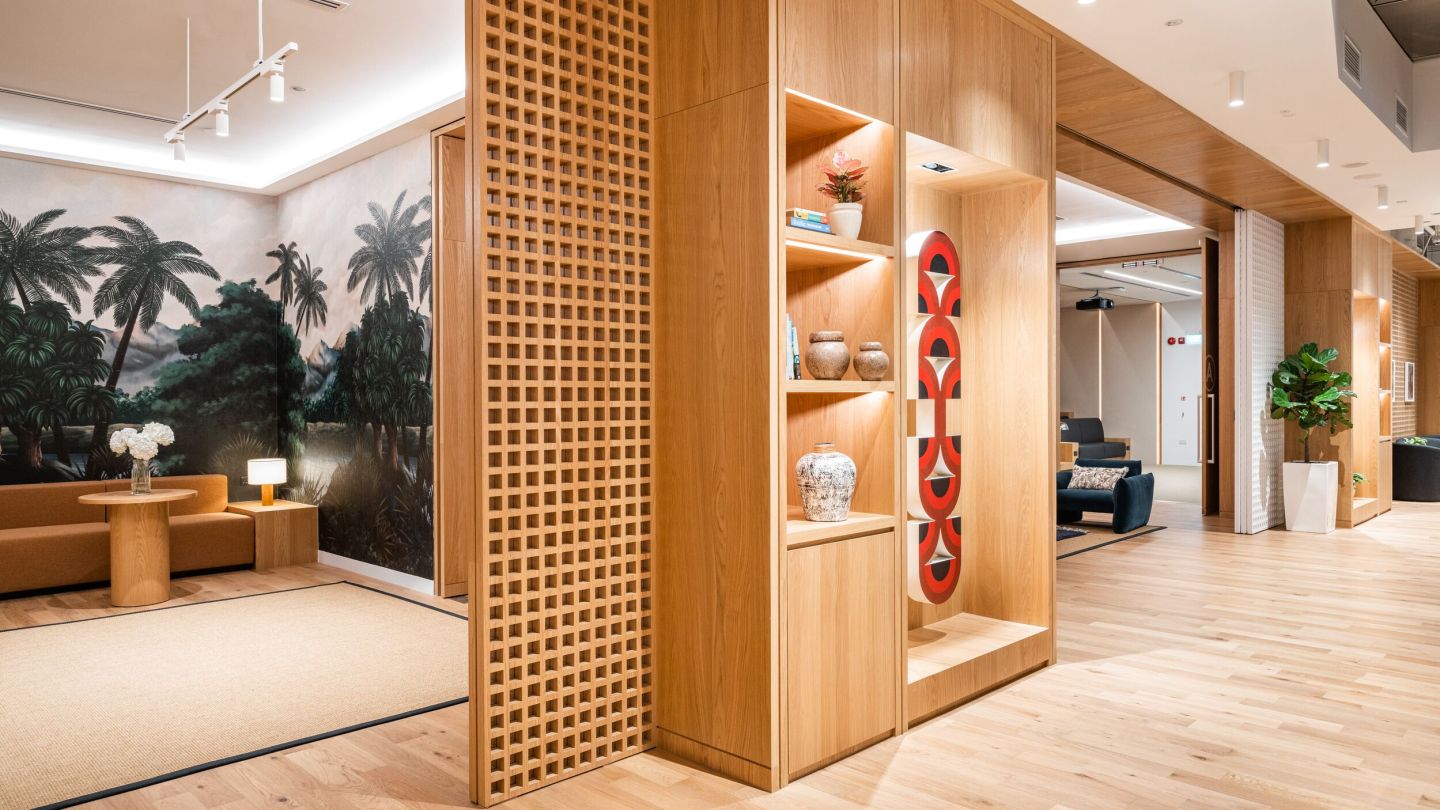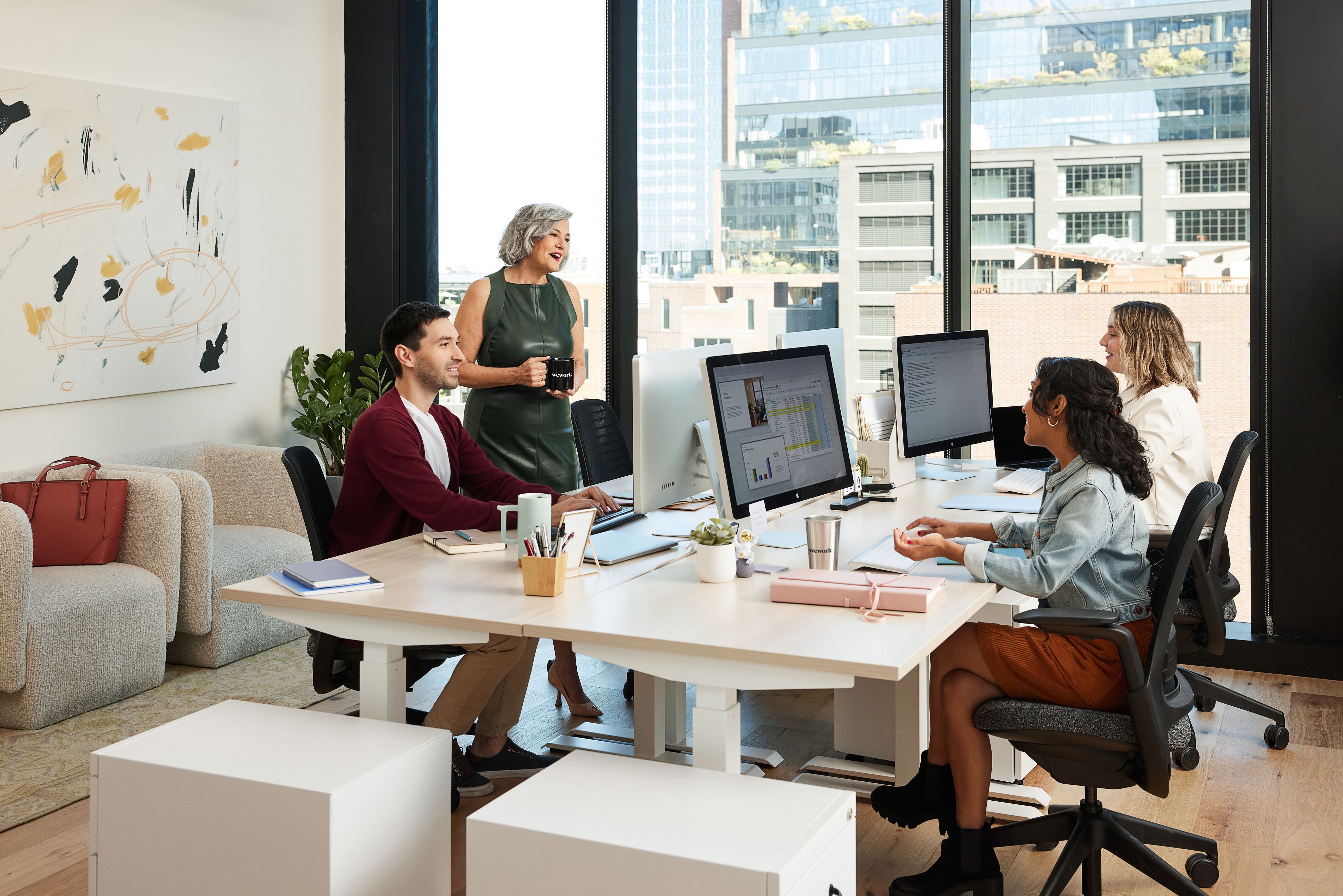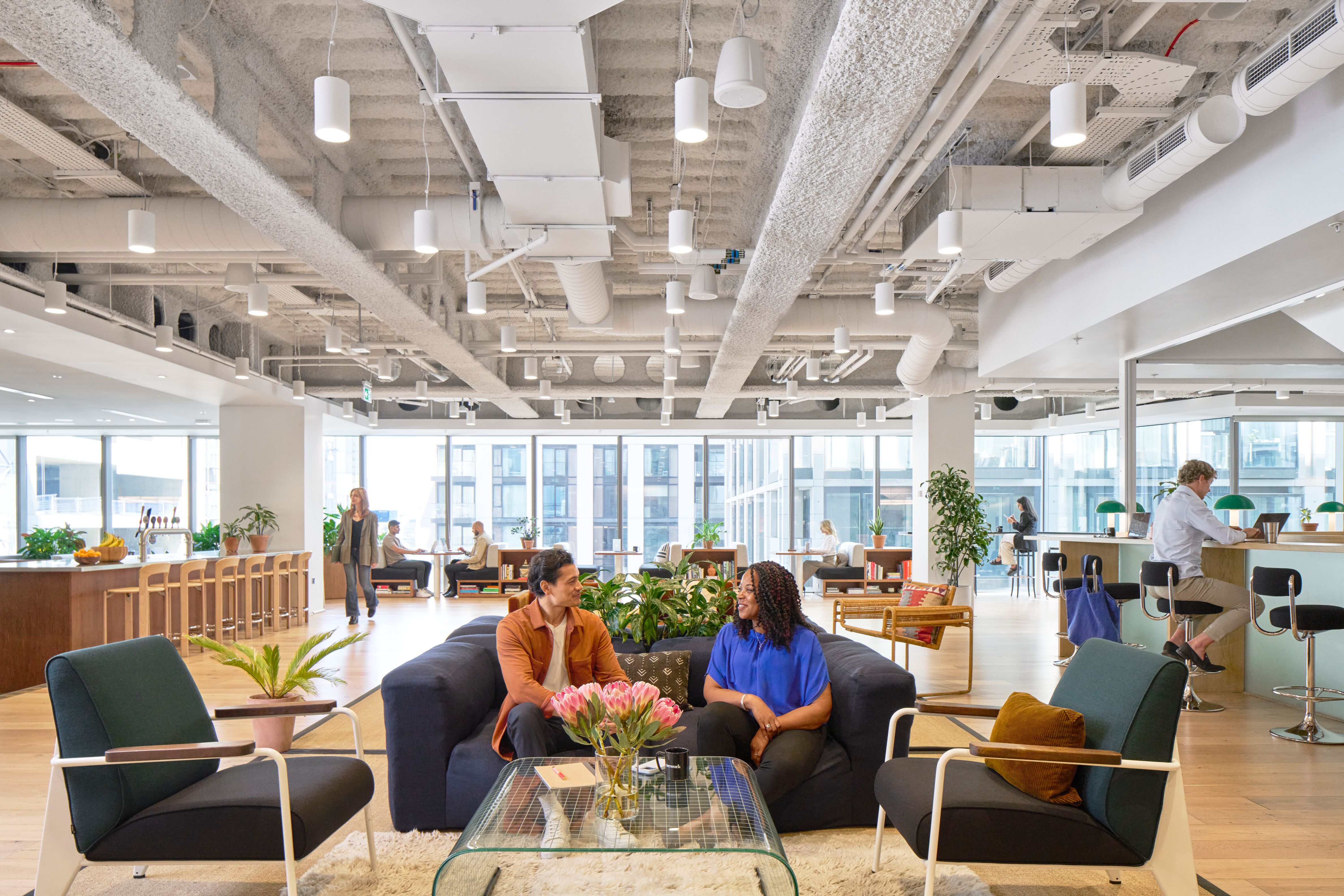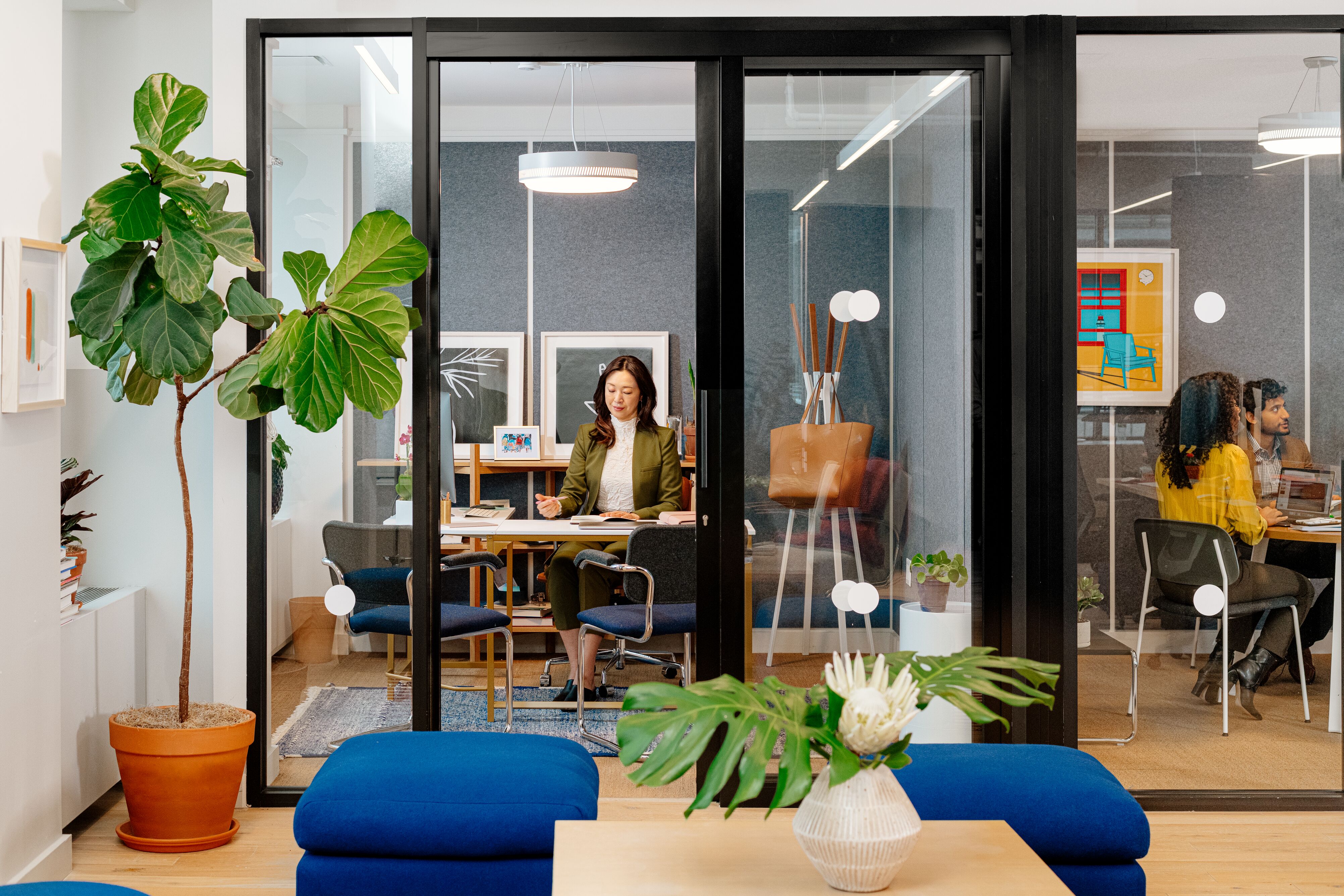Every WeWork space is intentionally designed to foster productivity and collaboration. Designed to Inspire delves into the architectural and artistic elements of these spectacular buildings.
Nestled among the upscale restaurants overlooking Singapore’s Marina Bay Sands, WeWork 21 Collyer Quay is one of the most coveted addresses in Lion City. “This building boasts some of the most amazing views in Singapore,” says Jessica Harrison, senior interior design studio manager at WeWork. “It’s right in the heart of the central business district.”
Architecturally, Singapore’s waterfront is a reflection of its famously diverse population and history. The neighboring buildings run the gamut from glittering skyscrapers to colonial mansions to traditional shophouses. For the WeWork design team, the challenge was to create a landmark space that lived up to its stylish surroundings.
“Although Singapore is such a young country, it has an amazing array of architecture and cultures,” Harrison says. With 21 stories to work with, the design team had an impressively large blank canvas. “It was about incorporating that charm and locality into the space throughout the 21 floors of the building,” she says.
The team took a holistic approach to the interior spaces, incorporating materials and furnishings that mirror the city-state’s cultural fabric in both obvious and subtle ways. Most significantly, they curated custom pieces by local artists to highlight key moments within the space.

“Art gives an identity to a workplace, especially when we can commission custom artworks,” says Loren Stuart, art and graphics manager at WeWork. “Being able to give context was important.”
For Stuart, showcasing a mix of established and emerging local artists was both a way to imbue the space with a sense of character and a form of social responsibility. “It’s always really important to be engaged with the local art scene wherever we open a WeWork,” she says. “As much as we want to find art that fits within our design direction, we also want to give a platform to our artists.”
On display are original works by Tiffany Loy, an experimental textile artist who integrates acrylics and other materials into her large-scale weavings; Ink & Clog, a design duo who created digital illustrations inspired by domestic life in Singaporean homes; and Chloe Ong, who uses an exuberant mix of pigments to explore the lines between Eastern and Western cultures.
Art gives an identity to a workplace, especially when we can commission custom artworks.
Loren Stuart, art and graphics manager at WeWork
The art market in Singapore has long focused on blue-chip galleries that make regular appearances at Art Basel Hong Kong. All that is slowly starting to change, thanks in part to conscientious efforts by curators. “There are a lot more institutions and new art fairs popping up that are geared toward showing Southeast Asian artists, connecting people with art that wasn’t as accessible before and giving Southeast Asian artists more of a platform,” she says.
Curating the custom pieces for WeWork 21 Collyer Quay was an integral part of the whole design process. “I work closely with the interior designer to decide which areas we want to highlight with custom art,” Stuart says. “Before we decide which artists we want to work with, we brainstorm local themes to explore within the art. So for Singapore, I focused on the botanical gardens—that synergy of art, nature, and biophilia and technology—as well as local textures, materials, and multicultural architecture.”
Those concepts manifest in pieces like a circular, suspended abstract painting on wood by Joanne Pang that greets members when they first arrive at reception. “The theory behind Joanne’s work is this exploration of emotions and the movement of people in and out of spaces. She pours and pushes paints and stains onto rigid, nonporous surfaces to reflect a sense of transformation and movement, which I think fits nicely with WeWork,” Stuart explains. The exterior side of the work visually echoes the leafy foliage just outside the building’s windows. “It’s all about that interaction you have with different people and colleagues on a daily basis,” Stuart says.
Facilitating these sorts of organic interactions was key to developing every element of the space. “The biggest driver was a conscious consideration of the member journey,” Harrison says.
Members continue that journey to a bespoke staircase that leads to an entire floor dedicated to wellness. Along the sides of the staircase are the same gorgeously detailed ceramic tiles found in Peranakan shophouses. The Peranakans, sometimes referred to as Baba-Nyonya, were merchants and traders who left their distinctive cultural mark from Singapore to Malacca to Penang.
“We wanted to be a bit bold, and we were thinking about ways we could incorporate those tiles,” Stuart says. “I came across this tile supplier based in Singapore named Victor Lim. He’s been finding and restoring these kinds of tiles since the 1970s. We procured these individual tiles, which highlight that deep multicultural influence.”
Lavishly decorated Peranakan homes often used imported European furnishings and works by local artisans to highlight the owner’s wealth and global influence. Harrison used lush materials to evoke some of that ambiance.
“We used a mixture of really rich emeralds, ruby reds, and blues in velvets, which contrasted beautifully with the simplicity of the black-and-white pieces,” Harrison says. “We wanted the furniture to have that timeless European feel and that rich texture.”
That rich materiality extends to other elements of the building as well. “Like a lot of WeWork locations, it has warmth and sophistication thanks to this combination of oak and walnut wood,” Harrison says. “We took a lot of inspiration from the ornate lattice detailing of shophouses, including this really beautiful square motif found throughout the design.”
The final effect is an of-the-moment contemporary workspace that nods to Singapore’s past, present, and future. As members gather over complimentary espresso drinks poured by expert baristas or head to the bar up top for an after-work drink, they’ll see the city’s futuristic skyline from a space filled with subtle references to historical art and architecture. Bold and unafraid to embrace diversity, it’s a workplace that embodies the spirit of its dynamic surroundings.
Diana Hubbell has spent more than a decade covering design, art, travel, and culture for publications including The Washington Post, The Guardian, Eater, Condé Nast Traveler, The Independent, VICE, Travel + Leisure, Architectural Digest, Atlas Obscura, and WIRED, among others.
Want to learn more about flexible work?


















